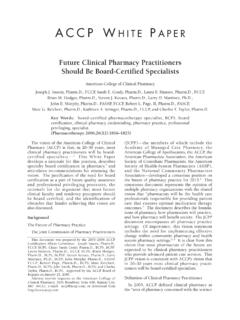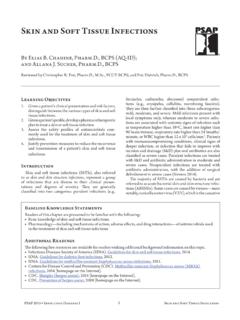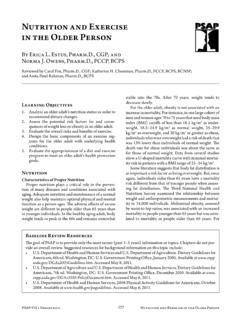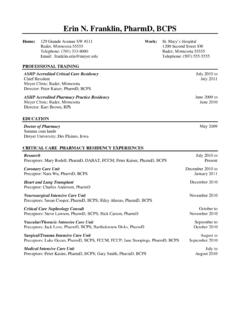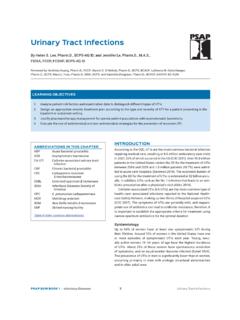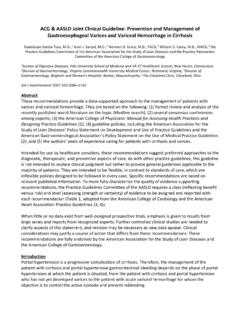Transcription of Management and Prevention of Upper GI Bleeding
1 Management and Prevention of Upper GI Bleeding By Jiwon Kim, , BCPS, FCSHP. Reviewed by Clarence Chant, , FCSHP, FCCP, BCPS; and Steven E. Pass, , FCCP, FCCM, BCPS. Learning Objectives UGIB. Bleeding from the Upper gastrointestinal (GI). tract is 4 times as common as Bleeding from the lower 1. Apply an understanding of the pathophysiology and risk factors for Upper gastrointestinal (GI) GI tract. The annual incidence of UGIB ranges from 48. Bleeding to patient care. to 160 cases per 100,000 individuals, with a higher inci- 2. Evaluate the most recent guidelines for manage- dence in men than in women. ment and Prevention of Upper GI Bleeding . Despite the advances in therapeutic Management , 3. Devise a plan to effectively manage acute GI mortality has remained unchanged at 10% to 14%, Bleeding and optimize treatment responses in the which may be related to longer life expectancy and the individual patient. higher number of comorbidities in the aging popula- 4. Design plans for the Prevention of Upper GI bleed- tion.
2 In patients with UGIB, comorbid illness is the pri- ing caused by commonly associated risk factors. mary cause of death, not the actual Bleeding . Medical comorbid illnesses are reported in of patients with UGIB, with a lower rate in men ( ) than in Introduction women ( ). Because rebleeding or continued Upper gastrointestinal Bleeding (UGIB) is a poten- Bleeding is associated with higher mortality, preven- tially life-threatening condition that requires prompt tion is the most effective strategy in the Management of and appropriate Management . Representing a signifi- UGIB. This chapter focuses on causes, risk factors, and cant clinical and economic burden in the United States, updated recommendations on the Management and UGIB annually produces a hospitalization rate of 165 Prevention of UGIB. per 100,000 adults (more than 300,000 hospitaliza- tions) at an estimated cost of $ billion. More people are hospitalized for UGIB than for congestive heart fail- Pathophysiology ure or deep venous thrombosis.
3 Peptic Ulcer Disease Upper gastrointestinal Bleeding is defined as bleed- Peptic ulcer disease remains the most common cause ing from a source proximal to the ligament of Treitz of UGIB, accounting for 21% to 40% of all Bleeding epi- and can be categorized as either variceal or nonvariceal. sodes. Recent data suggest a decline in the incidence of Variceal hemorrhage results from complications of end- Bleeding caused by ulcer; this is believed to be partly stage liver disease, and nonvariceal Bleeding is associ- caused by increased use of Helicobacter pylori eradi- ated with peptic ulcer disease (PUD) or other causes of cation therapy. H. pylori infection and chronic use of Baseline Review Resources The goal of PSAP is to provide only the most recent (past 3 5 years) information or topics. Chapters do not pro- vide an overall review. Suggested resources for background information on this topic include: Berardi RR, Fugit RV. Peptic ulcer disease. In: DiPiro JT, Talbert RL, Yee GC, Matzke GR, Wells BG, Posey LM, eds.
4 Pharmacotherapy: A Pathophysiologic Approach, 8th ed. New York: McGraw-Hill, 2011:563 86. ASHP therapeutic guidelines on stress ulcer prophylaxis. Am J Health Syst Pharm 1999;56:327 79. Chey WD, Wong BCY; Practice Parameters Committee of the American College of Gastroenterology. American College of Gastroenterology guideline on the Management of Helicobacter pylori eradication. Am J. Gastroenterol 2007;102:1808 25. PSAP-VII Gastroenterology and Nutrition 7 Management and Prevention of Upper GI Bleeding The role of H. pylori infection in patients with NSAID. Abbreviations in This Chapter use is somewhat controversial. Several studies suggest AASLD American Association for the that H. pylori infection and NSAID use are indepen- Study of Liver Diseases dent and synergistic risk factors for Bleeding PUD. A. GI Gastrointestinal meta-analysis showed that preemptive eradication of NSAID Nonsteroidal anti-inflammatory H. pylori in NSAID-naive users before the initiation of drug NSAIDs was associated with a decrease in the devel- PPI Proton pump inhibitor opment of peptic ulcers.
5 A more recent meta-analysis PUD Peptic ulcer disease concluded that the risk of PUD is significantly higher SRMD Stress-related mucosal damage in patients with H. pylori infection who are receiving TIPS Transjugular intrahepatic porto- chronic NSAID therapy than in those on NSAIDs with- systemic shunt out the infection. However, ulcers were more common UGIB Upper gastrointestinal Bleeding in patients with H. pylori infection compared with those without the infection, irrespective of NSAID use. Esophageal varices nonsteroidal anti-inflammatory drugs (NSAIDs) con- A prospective case series from two large tertiary care tinue to be the predominant causes of PUD leading to facilities showed that gastroesophageal varices were the Bleeding ulcers. second most common cause of UGIB. Esophageal vari- Duodenal ulcers are more common than gastric ulcers ces are present in about 50% of patients with cirrhosis, with H. pylori infection, but the incidence of Bleeding is and variceal hemorrhage occurs at a rate of 5% to 15% per similar for both.
6 Early studies showed that H. pylori infec- year depending on the severity of the liver disease. Gas- tion rates were lower in patients with Bleeding ulcers troesophageal varices develop because of systemic or seg- (71%) than in those with nonbleeding ulcers (93%). mental portal hypertension, leading to obstruction of the Recent data suggest that this discrepancy is caused by portal venous outflow caused by hepatic cirrhosis. Vari- the decrease in sensitivity of biopsy in patients with ces develop to decompress the hypertensive portal vein acute Bleeding ulcers. A possible mechanism involved in and return blood to the systemic circulation. Six-week increased false-negative rates of H. pylori testing is the pH mortality with each occurrence of variceal hemorrhage is buffering effect of blood; higher alkalinity has been asso- about 15% to 25%, and late rebleeding (within 1 2 years ciated with higher rates of false-negative results. of the initial Bleeding episode) occurs in about 60% to Nonsteroidal anti-inflammatory drugs, including aspi- 70% of patients not receiving prophylaxis.
7 Rin, continue to be a common cause of UGIB. Although Several clinical and physiologic factors are associated most NSAID-associated ulcers are asymptomatic and with variceal hemorrhage in patients with end-stage liver do not lead to Bleeding , elderly patients with a history of disease. Although varices may develop anywhere along Bleeding ulcer are at increased risk of rebleeding with con- the GI tract, the most common sites for liver disease . tinued NSAID use. A long-term prospective study showed related varices are the distal esophagus, stomach, and rec- that adults older than 65 years receiving chronic NSAID tum. The gastroesophageal junction has the thinnest tis- therapy for arthritis and low-dose aspirin therapy were at sue layer and the most likely area of variceal hemorrhage . increased risk of Upper GI complications, including UGIB. Major risk factors associated with variceal hemorrhage Aspirin in daily dosages of 75 300 mg has been shown include larger size and/or red appearance of the varices , to cause a 2- to 3-fold increased risk of GI Bleeding .
8 An increasing severity of liver dysfunction, and history of important determinant of NSAID-associated Bleeding is variceal hemorrhage episodes. the therapy duration because a short course ( , less than 1 week) of NSAID therapy in healthy individuals is less Stress-Related Mucosal Damage likely to result in GI Bleeding . Other risk factors associ- Stress-related mucosal damage (SRMD) and subse- ated with NSAID-induced UGIB include higher NSAID quent Bleeding remains the most common cause of acute dosages; history of GI injury from NSAIDs; history of UGIB in patients with critical illness, with a to PUD associated with H. pylori infection; and concurrent estimated incidence of overt GI Bleeding . Two major use of corticosteroids, anticoagulants, or bisphosphonates. risk factors for overt GI Bleeding in critically ill patients For some patients, genetic predisposition may also play a are mechanical ventilation for more than 48 hours and role in NSAID-associated GI Bleeding . Polymorphism of coagulopathy defined as a platelet count less than 50,000/.
9 Cytochrome P450 (CYP) 2C9 may delay the metabolism mm3 and/or an international normalized ratio (INR). of some NSAIDs and prolong the duration of ulcer-induc- greater than Other risk factors for SRMD and clini- ing effects. The risk of UGIB is also significantly higher in cally important Bleeding include surgery, trauma, organ patients with concomitant use of serotonin reuptake inhib- failure, sepsis, severe burns, and neurologic injuries. In itors and NSAIDs. addition, anticoagulants, high-dose corticosteroids, and Management and Prevention of Upper GI Bleeding 8 PSAP-VII Gastroenterology and Nutrition prolonged intensive care unit (ICU) stay may increase The most common clinical presentation of acute the risk of SRMD in critically ill patients. UGIB is hematemesis (30% of patients) and/or melena (20% of patients). Around 50% of patients present with Other Uncommon Causes of UGIB both hematemesis and melena, and up to 5% of patients A Mallory-Weiss tear is a longitudinal mucosal lacera- present with hematochezia, which is suggestive of a tion in the distal esophagus and proximal stomach.
10 This rapid and significant amount of blood loss. Hemateme- gastroesophageal tear leads to Bleeding from submuco- sis is indicative of Bleeding proximal to the ligament of sal arteries. The incidence of Mallory-Weiss tears among Treitz; frank bloody emesis suggests ongoing Bleeding , patients with UGIB is around 5%. These lacerations are whereas coffee-ground emesis suggests limited bleed- usually associated with a sudden increase in intra-abdom- ing. Melena usually indicates Bleeding proximal to the inal pressure, resulting in a gastric mucosal tear from the ligament of Treitz, although in some cases, the small forceful distention of the gastroesophageal junction. Pre- bowel or right colon may also be involved. cipitating risk factors for Mallory-Weiss tears include In the patient with a Bleeding peptic ulcer, epigastric vomiting, straining at stool or lifting, coughing, seizures, or right Upper quadrant pain often accompanies acute hiccups, cardiopulmonary resuscitation, blunt abdomi- Bleeding .


